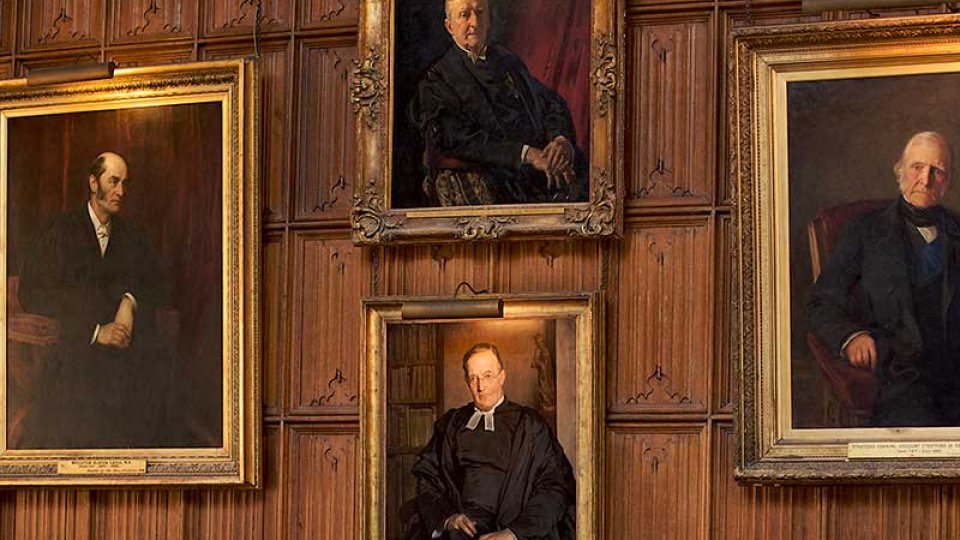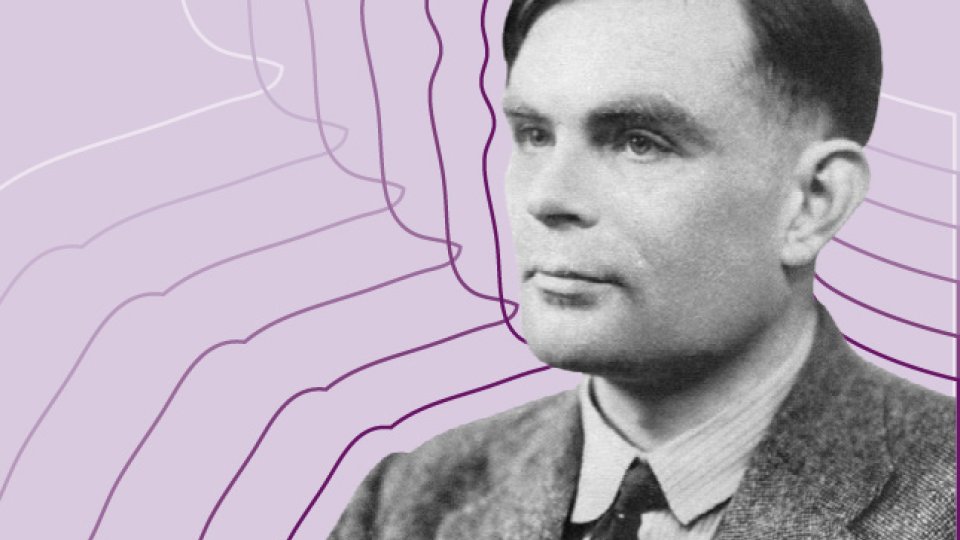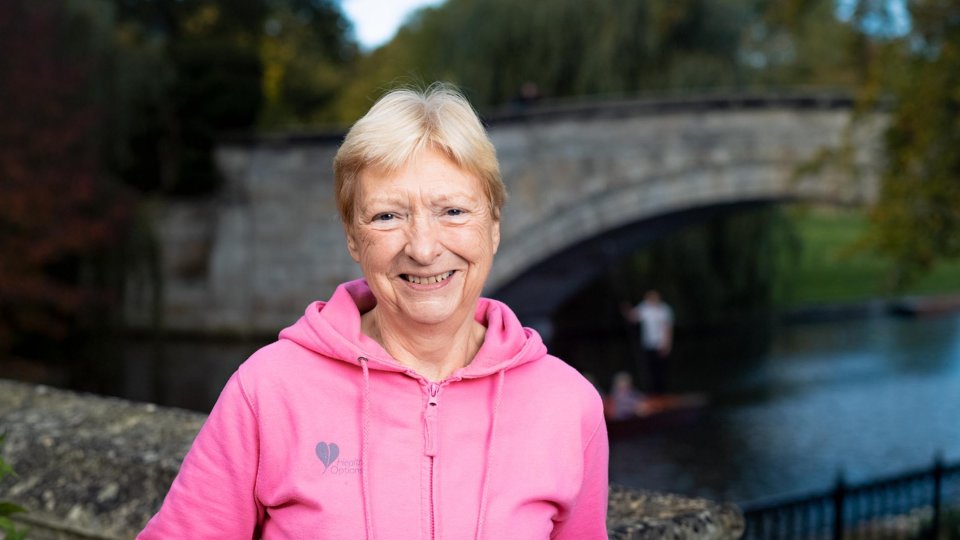King's has a strong tradition in research. Nobel laureates such as Patrick Blackett (Physics, 1948), Frederick Sanger (Chemistry, 1958, 1980), Richard Stone (Economics, 1984) Sydney Brenner (Medicine, 2002) and Geoffrey Hinton (Physics, 2024) feature among its alumni and past Fellowship.
Influential academics such as John Maynard Keynes and Alan Turing carried out much of their work in the College. Indeed Alan Turing's legacy in computing was responsible for his being chosen as the subject of a digital archive pilot project.
Alan Turing
Turing first came to King's as a scholar in 1931, and read mathematics as an undergraduate. He was elected into a Junior Research Fellowship in 1935 on the basis of a thesis on the central limit theorem. It was during his time as a Junior Research Fellow that he wrote his celebrated paper 'On Computable Numbers and the Entscheidungsproblem'. This referred to the Göttingen mathematician David Hilbert's program to demonstrate whether mathematics is decidable - that is, whether there exists a definite method that is in principle capable of deciding the truth of any mathematical assertion.
Turing introduced the notion of a Universal Machine (now called a Turing Machine). He showed that such a machine is capable of performing any mathematical computation given by an algorithm. He went on to prove that there was no solution to the Entscheidungsproblem by demonstrating that the halting problem for a Universal Turing machine was in general undecidable.
Turing's Junior Research Fellowship was interrupted by the Second World War, during which he famously worked at Bletchley Park on the deciphering of the Enigma code. In 1945, Turing left King's College to move to first the National Physical Laboratory, and then the Royal Society Computing Laboratory at Manchester University, where he played a fundamental role in developing the first electronic computers.
The Association for Computing Machinery named their A.M. Turing Award after him, which is seen as the 'Nobel Prize for Informatics/Computing'.
John Maynard Keynes
Keynes was admitted to King's in 1902 to read mathematics. He graduated as twelfth Wrangler in 1905 and his first researches were on probability. He submitted early drafts of his Treatise on Probability for a Junior Research Fellowship in 1908 but was unsuccessful and his interests gradually turned towards economics.
He returned to King's as a lecturer in 1909, taking up a position funded by Alfred Marshall to promote the teaching of economics. His real fame developed during and after the First World War, when he acted as an economic advisor to the British government.
In his famous book The Economic Consequences of the Peace, he predicted that reparations would bankrupt Germany and lead to further conflict in Europe. In 1936, he published The General Theory of Employment, Interest and Money, which is often considered to be the foundation of modern macroeconomics. Keynes theorised on how to manage the economy while avoiding the mass unemployment of the Great Depression. He introduced his idea that the total income is the sum of consumption and investment. In a state of unemployment, the total income can only be increased by first increasing expenditure for consumption or investment. His ideas influenced US President Franklin Roosevelt's New Deal.
He played a pivotal role in international economic policy during and after the Second World War. As Bursar of King's in the inter-war years, Keynes substantially improved the financial position of the College. He also became very wealthy himself, and famous as a patron of the arts and sciences, buying Impressionist paintings and scientific manuscripts. This portrait is by the Bloomsbury group artist Duncan Grant.
Patrick Blackett
Blackett was an undergraduate at Magdalene College, Cambridge. From 1923-1933, he was a Fellow of King's College, whilst pursuing experimental researches in nuclear physics at the Cavendish Laboratory. These were initially under the direction of Rutherford, who asked him to investigate the disintegration of nitrogen nuclei by fast alpha particles.
Blackett used the cloud chamber, which provides visible tracks of the decay products. He found that some of the trails were forked, tell-tale signs that the nitrogen atom had disintegrated into an isotope of oxygen and a proton. Blackett's background in nuclear physics led him on to the study of the most energetic particles in the Universe, namely the cosmic rays. These are mainly protons, helium and other nuclei, and electrons produced in space by astrophysical mechanisms and which impinge upon the Earth's atmosphere.
In 1932, Blackett in collaboration with Giuseppe Occhialini devised an ingenious system of Geiger counters, which only took photographs when a cosmic ray particle traversed a cloud chamber. This technical advance led to a study of the tracks of the high energy cosmic rays, including ones confirming the existence of the positron (itself predicted in Cambridge by Paul Dirac) and the phenomenon of electron-positron pair-production. This was the work for which he received the award of the Nobel Prize for Physics sixteen years later in 1948.
Blackett left King's in 1933 to become Professor of Physics in turn at Birkbeck College, then Manchester University and finally Imperial College, London.
Nobel Laureates
King's College numbers several Nobel laureates:
- 2024: Geoffrey Hinton (King's College). Prize in Physics, for his contribution to the development of machine learning with artificial neural networks.
- 2016: Oliver Hart (King's College). Prize in Economics, for his contribution to contract theory.
- 2002: Sydney Brenner (King's College). Prize in Medicine, for discoveries concerning genetic regulation of organ development and programmed cell death.
- 1984: Richard Stone (Caius College and Fellow of King's College). Prize in Economics, for developing a national income accounting system.
- 1980: Frederick Sanger (St John's College and Fellow of King's College). Prize in Chemistry, for the theory of nucleotide links in nucleic acids.
- 1974: Patrick White (King's College). Prize in Literature, for an epic and psychological narrative art.
- 1959: Philip Noel-Baker (King's College). Prize in Peace, for work towards global disarmament.
- 1958: Frederick Sanger (St John's College and Fellow of King's College). Prize in Chemistry, for the structure of the insulin molecule.
- 1948: Patrick Blackett (Magdalene College and King's College). Prize in Physics, for nuclear physics and cosmic radiation.
- 1922: Archibald Hill (Trinity College and King's College). Prize in Physiology or Medicine, for heat and mechanical work in muscles.
- 1917: Charles Glover Barkla (Trinity College and King's College). Prize in Physics, for his discovery of the characteristic Röntgen radiation of the elements.






